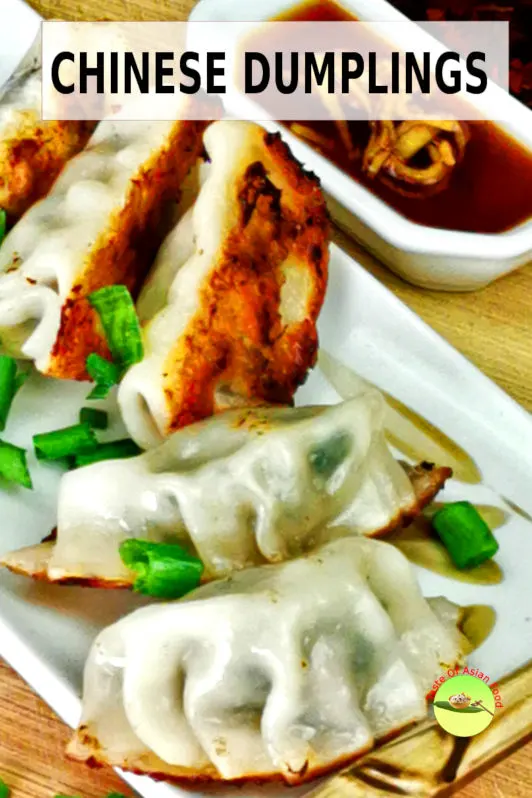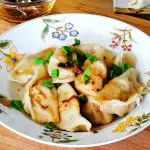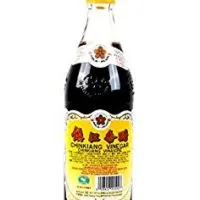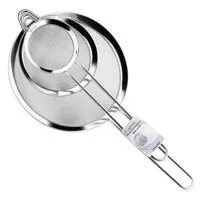Eating Chinese dumplings is a delightful experience. The juice flowing from the filling flows immediately to every corner of your mouth, waking up all the taste buds and sending you a euphoric feeling.
That’s pure food love, and you know that one bowl of these delicate dumplings will never be enough!

Making Chinese dumplings is a custom in Northern China during the Chinese New Year. It is when all the family members reunite, no matter how far they have traveled. Every member will gather in the kitchen on Lunar New Year, taking up their respective roles assigned by the grandparents since childhood – preparing the filling, wrapping, and shaping the dumplings.
This dumpling-making ritual is a family affair. It’s the moment the youngster retell their childhood stories and share their encounters while away from home. The elderly will repeat the same old advice to their grown-up children as if they are still three-year-old kids in their memory.
Note: This post may contain affiliate links. Please read my privacy policy for more info. I may receive commissions for purchases made through links in this post. As an Amazon Associate, I earn from qualifying purchases.
What is in this article
I will explain how to make the best dumplings from scratch in this article. Assuming you are single-handedly preparing a batch of homemade dumplings, I will make it as simple as possible. Of course, you get your parents, siblings, and kids involved to make a large batch, just like we did during our New Year reunion gathering.
Here are what you will read:
- Two classic Chinese dumpling filling recipes, one with pork and Chinese cabbage (Napa cabbage), and the other is chive dumplings.
- How to make the dumpling wrappers. (You can use the store-bought one to save time).
- A foolproof method to wrap the dumplings.
- Two ways to cook the dumplings.
- How to make the dipping sauce.
Let’s get into the details right now.
1. How to make the classic dumpling filling
Making the dumpling filling is easy. Here are the steps :
- Ground meat (chicken, ground pork, or beef)
- Chop the vegetables (chives, cabbage, or green onion)
- Combine the meat, vegetables, and seasonings.
- Mix the filling by throwing it repeatedly into the bowl.
- Let the filling rest in the refrigerator.
Chinese pork dumpling is the most common, followed by chicken and beef. If you do not eat pork, any pork filling can be substituted with chicken meat for a pork-free recipe. Also, there are dumplings made only with vegetable filling.
How to make a juicy filling?
Here are some tips for you:
- If you use pork or beef, choose the meat with at least 20% of fat.
- If you use chicken meat, increase the fat content by including 1 to 2 tbsp of cooking oil for every 250g (8 oz) of chicken in the filling.
- Add water to the filling. If you repeatedly throw the meat into the bowl, you will be surprised that the filling can hold up to five to six tablespoons of water for every 250g of minced meat.
In Chinese, this throwing process is called Da Xian (打馅), which means “beat the filling.” Slamming the meat paste against the bowl will break down the protein and restructure it to develop a springy texture. It also helps to absorb more liquid to make it juicier. The well-beaten meat should eventually become a springy and sticky mass. It also causes the meat to disintegrate partially, resulting in meatballs feeling melted in the mouth.
Note: For the pork and chives filling, I seasoned it with salt, wine, ground white pepper, sesame oil, light soy sauce, sugar, and handsome cornstarch. You may add some oyster sauce, although I omitted it in my recipe.
Is there any special treatment for the vegetables?
You only need to chop coarsely if you are dealing with dry vegetables, such as green onion and chives. However, there is a unique treatment if you use cabbage, which has plenty of water. Here is how:
- Chop the leafy part of the cabbage coarsely.
- Chop the stem finely since it is harder.
- Add two teaspoons of salt to 250g (8 oz) of chopped cabbage and mix well.
- Set aside for 15 minutes. The salt will draw out the water from the cabbage due to osmosis. (Take a look at the video in this article. A lot of water!)
- Squeeze out the water from the cabbage before mixing it with the minced meat. Otherwise, it is too wet to form a proper filling.
- Don’t forget to adjust the saltiness of the filling!
I used the pork and chive filling in the recipe below and added an alternative using cabbage and green onions in the note section in the recipe. (I know. Chinese chives may not be readily available in certain places).
2. How to make the dumpling wrapper
Making dumpling wrappers is easy as it only requires flour and water.
But the process is tedious, so many people use store-bought dumpling wrappers.
The choice is yours. But even if you decide to use the ready-made dumpling wrappers, it is worth making it at least once. You will notice there are noticeable differences. Homemade wrappers are softer and stickier. It has to be used immediately after rolling into a thin dough sheet, and it tends to dry out. The dough is stickier and seals well when you pinch and pleate the dumpling.
On the contrary, the store-bought ones are added with cornstarch to prevent them from sticking together. As a result, you need to wet the peripheral with some water to make it sticky. Otherwise, it will not seal firmly and open up while cooking. Alternatively, you can buy wonton wrappers as a substitute. You can get it at Asian grocery stores.
Here is how to make your dumpling wrappers :
a. Knead the dough
- Measure the amount of all-purpose flour and warm water accurately. I use 50 to 53 ml of water for every 100g of flour. It is crucial not to make it too wet because the dumpling skin will become too soft to handle during wrapping.
- Mix the water and flour in a large bowl until they clump together.
- Transfer the loose dough to a work surface. Knead the dough until it becomes smooth and shiny. The kneading will take a while, generally between seven to ten minutes. You can use the electric mixer and dough hook to take over the manual work. Stop once it becomes smooth and shiny.
- Cover the dough and let it rest for at least two hours.
b. Divide the dough into small portions
- After two hours, transfer the dough to the work surface again.
- The dough should have become soft and stretched to paper-thin without breaking by now. If it is not, knead for a few minutes, cover it, and let it rest for half an hour.
- Roll the dough to form the shape of the rolling pin. Divide it into three sections. Work with one section each time and cover the rest in a floured container.
- Roll out each section and divide it into ten equal portions. Each portion should weigh between 12 to 14 g. Dust the dough with flour to avoid sticking to the work surface.
c. Roll the dough into a thin circle
There is no fixed way to roll out the dumpling dough. The goal is to roll it to become a circle, which is ideal for the dumplings. You can watch how I do it in the video for the details. In short, here is how :
- Flour the work surface heavily so the dough can freely rotate while rolling it out.
- Roll it to become a ball, then flatten it with the palm to turn it into a disc
- Roll out the dough with a rolling pin on one side of the disc. Turn the dough slightly after each stroke. The dough will eventually become a round, thin sheet since I make multiple short, light strokes parallel to the circumference, with a slight turn in between.
- Roll out the dough to form a circle of about 6 cm (2.4 in). (Please refer to the video at 7.10 minutes).
3. How to wrap the filling
The major challenge of making Chinese dumplings is how to wrap them neatly so that they look great. Many of us are not experts in wrapping it, including me.
It is understandable because we do not do this often and naturally do not have the dumping seller’s skill who performs it for a living.
I found a simple way to wrap it with the minimum skill required after trying a few methods. If I can do it with my clumsy skill, so can you. Here is how:
- Sprinkle some flour on the work surface.
- Place a piece of dumpling wrapper on it. Cover the remaining wrappers with a damp cloth.
- Place a tablespoon of the filling in the center of the wrapper. Be careful so that the peripheral of the wrapper is clear from any filling.
- Fold the wrapper in half by holding two opposite points of the edges and pinch them together at the meeting point.
- With the center point secure, press the edges together to get an airtight seal.
- If you are proficient, you can try a simple pleading method, as shown in the video. It is shown from 8.03 minutes to 9.43 minutes.
Note:
- Since I visually divide the dough into individual portions, they are not the same size. Therefore, the filling you need may vary, but it should be between 12g and 15g each (about one oz).
- If you use the freshly made dumpling wrapper, it should seal up easily as it is quite sticky. However, the store-bought wrappers are added with starch to prevent them from sticking together in the packaging. Therefore, you need to apply some water at the edges of the wrapper to make it sticky before wrapping the filling.

4. How to cook Chinese dumplings
There are two ways to cook Chinese dumplings- boiling and pan-frying. This dumpling recipe is not for steaming. If you want steamed dumplings, please check out my shrimp dumpling recipe here.
a. Soup dumplings (水饺)
I prefer the boiled dumplings as the easiest way to cook, and the texture is soft and tender.
- Bring a large pot of water to a boil.
- Place the dumplings into the water, one by one, to avoid them from sticking together. It is important not to cook too many dumplings each time to allow sufficient space for them to move around.
- Gently push the dumplings around from time to time.
- After three to four minutes, the dumplings will float to the top. Each dumpling will look puffier than before. At this point, the dumplings are thoroughly cooked.
- Transfer the dumplings to a bowl immediately to avoid them from overcooking, turning soggy, and potentially falling apart.
b. Pan-fried dumplings (potstickers, 锅贴)
This method is similar to making the Japanese gyoza. It is pan-fried on the bottom side and is also called potstickers. They are crispier and chewier than boiled dumplings.
- Add some oil to a frying pan or a large skillet.
- Arrange the dumplings into the pan.
- Fill up the pan with water enough to cover half of the dumplings.
- Cover the pan with a lid and cook it over medium heat. The steam inside the pan will start to cook the dumplings.
- Remove the lid when most of the water has evaporated after a few minutes.
- The pan’s oil will start pan-frying the bottom of each dumpling. Do not flip over them; they should only be pan-fried on the bottom.
- When the bottom has turned golden brown, remove the homemade potstickers and serve.
Cook the dumplings immediately or freeze them
The freshly made Chinese dumplings should be cooked as soon as possible, preferably within half an hour. The moisture from the filling will slowly release and seep into the dough, causing it to fall apart during cooking.
If you do not cook them immediately, arrange the dumplings in a single layer on a pan lined with a baking sheet plastic wrap), and keep them in the freezer. Keep the uncooked dumplings in airtight containers or freezer bags, as they are no longer sticky.
You can cook the frozen dumplings directly without defrosting them.
5. How to make the dumpling dipping sauce
Chinese dumplings are usually served with some Chinkiang black vinegar. Here are three easy ways to make the dumpling sauce by adding some simple ingredients to the vinegar.
- Add some finely chopped fresh ginger to the rice vinegar.
- Mix one tablespoon of vinegar, one teaspoon of light soy sauce, and half a teaspoon of sesame oil to become a dipping sauce.
- Mix one tablespoon of vinegar with a quarter teaspoon of Szechuan chili oil for a spicier version.
Chinese Dumplings - How to make it from scratch

Eating Chinese dumplings is a delightful experience. The juice flowing from the filling flows immediately to every corner of your mouth, waking up all the taste buds and sending a euphoric feeling through your senses.
Ingredients
The wrapper (A)
- 250g (8.8 oz/ 2.8 cups) all-purpose flour
- 140ml (0.6 cups) warm water
The filling (pork and chives) (B)
- 250g (8.8 oz) minced pork, with 20% fat
- 150g (5.2 oz) Chinese chives
- 1/4 tsp salt
- 2 tsp Shaoxing wine
- 1/4 tsp ground white pepper
- 1/2 tsp sesame oil
- 2 tsp light soy sauce
- 1 tsp sugar
- 2 tsp cornstarch
Instructions
The wrapper
- Mix A in a bowl, then transfer to a table and knead for 10 minutes or until the surface is shiny and smooth. Cover and set aside for 2 hours.
- Roll out the dough. Divide it into three equal portions, and then each one is subdivided into ten smaller portions.
- Roll each portion into a ball, then flatten it to become a disc.
- Roll each disc into a thin circle.
The filling
- Mix B together, then slam the mixture into the bowl repeatedly until it becomes a springy paste.
Wrapping.
- Wrap a tablespoon of the filing with the wrapper. Please refer to the video for the simple method I use.
The sauce
- Version 1; Add some finely chopped ginger to the vinegar.
- Version 2: Mix one tablespoon of vinegar, one teaspoon of light soy sauce, and half a teaspoon of sesame oil.
- Version 3: Mix one tablespoon of vinegar with a quarter teaspoon of Szechuan chili oil.
Making boiled dumplings
- Place the dumplings into the boiling water over medium heat, one by one. Stir occasionally.
- After three to four minutes, the dumplings will start to float to the top. Transfer the dumplings to a bowl immediately, and serve.
Making potstickers
- Add some oil to a frying pan.
- Arrange the dumplings in the pan.
- Fill up the pan with water enough to cover half of the dumplings.
- Cover the pan with a lid and cook it over medium heat.
- Remove the lid when most of the water has evaporated after a few minutes.
- The oil in the pan will start to pan-fried the bottom of each dumpling.
- When the bottom has turned color, remove and serve.
Notes
Cabbage and green onion filling:
200g Chinese cabbage, 2 tsp salt, 250g pork, 1 tsp sesame oil, 1 tsp light soy sauce,
1 tsp Shaoxing wine, 1/2 tsp pepper, 2 tsp oyster sauce, 1/2 tbsp minced garlic, 1/2 tsp minced ginger, 30g chopped green onion, 1 tbsp oil
Recommended Products
As an Amazon Associate and member of other affiliate programs, I earn from qualifying purchases.
-
 Gold Plum Chinkiang Vinegar 18.6 fl oz
Gold Plum Chinkiang Vinegar 18.6 fl oz -
 IPOW IP01115 Stainless Steel Fine Tea Mesh Strainer Colander Sieve with Handle for Kitchen Food Rice Vegetable, Set of 3
IPOW IP01115 Stainless Steel Fine Tea Mesh Strainer Colander Sieve with Handle for Kitchen Food Rice Vegetable, Set of 3 -
 Rolling Pin & Silicon Pastry Mat,Silicone Large Pastry Mat With 19.6" x 15.7",Dough Roller Sleek and Sturdy 11.8" Perfect Match
Rolling Pin & Silicon Pastry Mat,Silicone Large Pastry Mat With 19.6" x 15.7",Dough Roller Sleek and Sturdy 11.8" Perfect Match -
 GreenLife CW002044-002 Healthy Nonstick Dishwasher Oven Safe Sta Soft Grip Diamond Reinforced 8" Ceramic Non-Stick Open Frypan, 8-Inch, Black
GreenLife CW002044-002 Healthy Nonstick Dishwasher Oven Safe Sta Soft Grip Diamond Reinforced 8" Ceramic Non-Stick Open Frypan, 8-Inch, Black
Nutrition Information:
Yield:
30Serving Size:
1Amount Per Serving: Calories: 54Total Fat: 1gSaturated Fat: 0gTrans Fat: 0gUnsaturated Fat: 1gCholesterol: 7mgSodium: 49mgCarbohydrates: 7gFiber: 0gSugar: 0gProtein: 3g
This data was provided and calculated by Nutritionix on 1/18/2021

Gloria
Tuesday 19th of January 2021
Mr KP Kwan, I submitted a request to received "Get The Best Asian Recipes Free!" with my name and email, however I never received an email the download for said recipe book. Is it coming or not if not can you tell me why?
KP Kwan
Wednesday 20th of January 2021
Hi Gloria, I have just sent the book to you manually. Please check your email. It may be due to technical reasons that it did not send through (by an automated sending service). Sorry for the delay. KP Kwan
Marie Ramasamy
Tuesday 19th of January 2021
Pot Stickers & Shanghai Noodles are our family favourites. Thank you, Kwan for your easy-to-follow instructions.
KP Kwan
Wednesday 20th of January 2021
You are welcome. Enjoy.
KP Kwan
Tuesday 19th of January 2021
Hi, this is KP Kwan. I am happy to see you in this comment area, as you have read through my recipe. I am pleased to reply to any questions and comments as soon as possible.